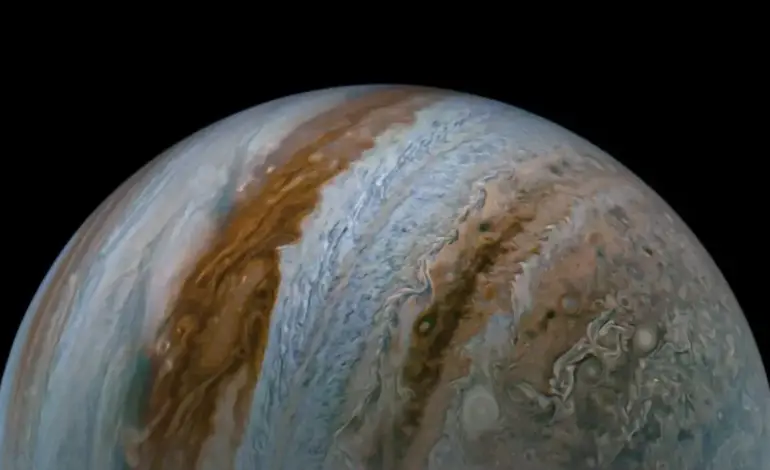Jupiter’s Vital Role in Shaping Earth’s Development Unveiled

New research from Rice University in Houston reveals that Jupiter played a critical role in the formation of Earth, potentially safeguarding its ability to host life. The study indicates that without the gas giant’s presence, primitive Earth may have drifted too close to the sun, rendering it inhospitable. This finding emerges from a broader investigation into the formation timeline of solid objects in the solar system.
Scientists have long been puzzled by why the earliest solid materials did not all form simultaneously. Evidence from meteorites—rocky debris that falls to Earth—shows two distinct generations of planet-building materials. The first group appeared swiftly within the first million years of the solar system’s history, while the second group, which contributed to the rocky planets including Earth, Mars, and Venus, formed 2 to 3 million years later. Understanding how enough dust remained to support this second wave of material has been a longstanding mystery.
To explore this, researchers conducted detailed computer simulations of the young solar system. The results, which are published in the journal Science Advances, highlight Jupiter’s mass—more than double that of all the other planets combined—as a key factor in this process. Prior models failed to adequately explain the age disparity in ancient planet-building materials. This research uniquely integrates Jupiter’s growth, the movement of dust, and the formation of asteroids into a cohesive explanation.
Baibhav Srivastava, a planetary scientist and co-author of the study, stated, “Our Earth might have become a ‘super-Earth.’ This may have significant implications for the potential habitability of Earth as well, since it may have left the ‘Goldilocks’ zone of the solar system.” The Goldilocks zone is the region around a star where conditions are just right for liquid water to exist on a planet’s surface.
Jupiter’s immense gravity has led many scientists to refer to it as the architect of the solar system. Its gravitational influence not only shaped the orbits of neighboring planets but also sculpted the gas and dust from which they originated. The solar system itself is approximately 4.5 billion years old.
As Jupiter grew, it reshaped its environment, draining gas from the inner solar system and creating regions of higher pressure that effectively trapped dust in ring-like formations. These “dust traps” enabled the formation of new solid objects long after the initial ones, providing a natural explanation for the age gap of rocky materials.
The timing of this second generation aligns with that of ordinary chondrites, the most commonly found type of stony meteorite on Earth. Scientists have estimated the ages of these meteorites’ parent bodies by analyzing isotopes within them. Some isotopes are radioactive, decaying into other elements at a predictable rate. By comparing the remaining isotopes to their decayed forms, researchers can determine the solidification timing of the rocks, akin to carbon dating but utilizing heavier elements such as lead, rubidium, and strontium.
By the time this second wave of rocky material solidified, Earth was already in formation, limiting its contribution to the planet. The findings suggest that Jupiter’s formation must have occurred very early, within the first 2 million years of the solar system. This early emergence provided the young planet ample time to shape the surrounding gas and dust.
The study’s conclusions reflect observations made by astronomers using powerful telescopes to examine other emerging star systems. André Izidoro, a Rice assistant professor and study author, noted, “Looking at those young disks, we see the beginning of giant planets forming and reshaping their birth environment. Our own solar system was no different. Jupiter’s early growth left a signature we can still read today, locked inside meteorites that fall to Earth.”
The implications of this research extend beyond mere academic curiosity. Understanding Jupiter’s influence on Earth’s development can provide insights into planetary formation processes and the potential habitability of other worlds within similar systems. The study underscores the intricate relationships between celestial bodies and the conditions necessary for life to flourish.






